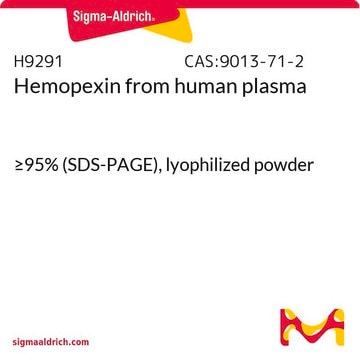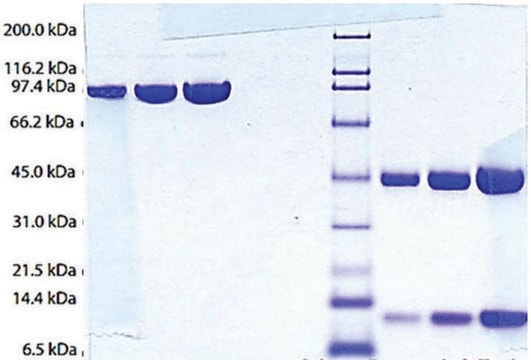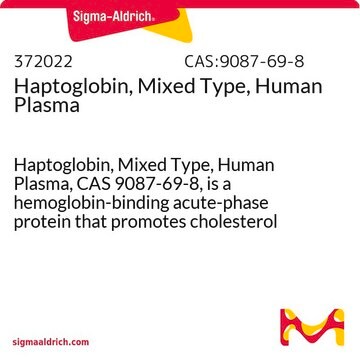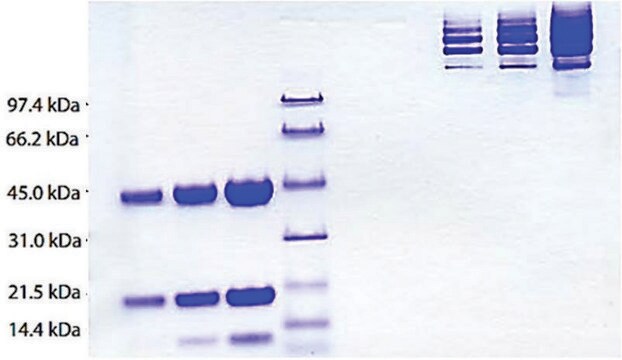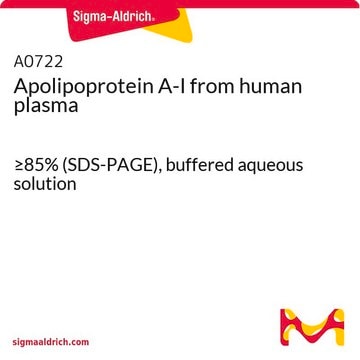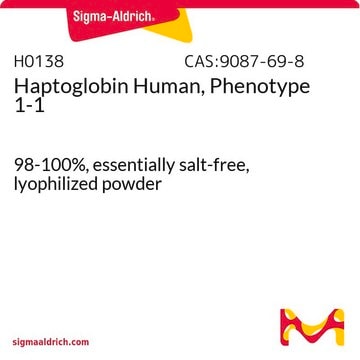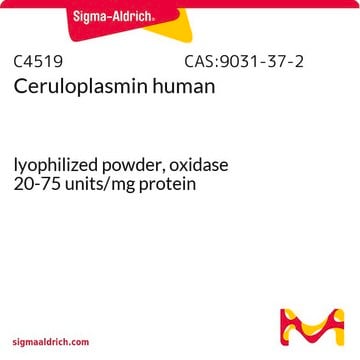H3536
Haptoglobin from pooled human plasma
≥95% (SDS-PAGE), lyophilized powder
Synonym(s):
Haptoglobin from human plasma
Sign Into View Organizational & Contract Pricing
All Photos(1)
About This Item
Recommended Products
biological source
human plasma (pooled)
Quality Level
Assay
≥95% (SDS-PAGE)
form
lyophilized powder
technique(s)
activity assay: suitable
solubility
H2O: soluble 10 mg/mL
UniProt accession no.
storage temp.
−20°C
Gene Information
human ... HP(3240)
Looking for similar products? Visit Product Comparison Guide
General description
Haptoglobin is an α2-globulin found in normal plasma at a concentration of 82-236 mg/dl and accounts for 0.4-2.6% of the total plasma proteins.The monomeric form of this acute phase plasma protein is composed of four polypeptide chains: two α chains and two β chains.
Haptoglobin is an acute phase protein that scavenges hemoglobin released into the circulation. Haptoglobin, the plasma protein with highest binding affinity to hemoglobin, is mainly expressed in the liver.
Application
Haptoglobin was used to study induction of the acrosome reaction in sperm. Exposure to low temperature increases their rate of fusion with zona-free hamster oocytes.
Biochem/physiol Actions
Functions by binding to plasma hemoglobin (from hemolysis). The complex is removed from the circulation, by binding to CD163 receptors on macrophages, to salvage iron and prevent oxidative damage.
Other Notes
Occurs as 3 major phenotypes: type 1-1, type 2-1, type 2-2.
Disclaimer
RESEARCH USE ONLY. This product is regulated in France when intended to be used for scientific purposes, including for import and export activities (Article L 1211-1 paragraph 2 of the Public Health Code). The purchaser (i.e. enduser) is required to obtain an import authorization from the France Ministry of Research referred in the Article L1245-5-1 II. of Public Health Code. By ordering this product, you are confirming that you have obtained the proper import authorization.
Storage Class Code
11 - Combustible Solids
WGK
WGK 3
Flash Point(F)
Not applicable
Flash Point(C)
Not applicable
Certificates of Analysis (COA)
Search for Certificates of Analysis (COA) by entering the products Lot/Batch Number. Lot and Batch Numbers can be found on a product’s label following the words ‘Lot’ or ‘Batch’.
Already Own This Product?
Find documentation for the products that you have recently purchased in the Document Library.
Customers Also Viewed
Eiko Shimada et al.
Transfusion, 47(12), 2315-2321 (2007-09-04)
Congenital haptoglobin deficiency is a risk factor for anaphylactic nonhemolytic transfusion reactions in Japan. The deleted allele of the haptoglobin gene, Hp(del), which causes congenital haptoglobin deficiency, has also been observed in other Northeast Asian populations, such as Korean and
R Sanchez et al.
International journal of andrology, 14(6), 423-430 (1991-12-01)
The fusion rate of human sperm with zona-free hamster ova was investigated after induction of the acrosome reaction by exposure to a low temperature (4 degrees C). Sperm were collected from 14 patients, and selected by the 'swim-up' method. The
I B Ross et al.
Journal of neurotrauma, 8(4), 229-238 (1991-01-01)
Previously in our laboratory, nimodipine was effective in reversing posttraumatic ischemia and promoting electrophysiologic recovery in a rat spinal cord injury (SCI) model. However, these beneficial effects were achieved when nimodipine was combined with adjuvant therapy to reverse posttraumatic hypotension
Naoko Osada et al.
The Journal of biological chemistry, 298(9), 102400-102400 (2022-08-22)
The N-glycans attached to proteins contain various GlcNAc branches, the aberrant formation of which correlates with various diseases. N-Acetylglucosaminyltransferase-IVa (GnT-IVa or MGAT4A) and Gnt-IVb (or MGAT4B) are isoenzymes that catalyze the formation of the β1,4-GlcNAc branch in N-glycans. However, the
Alexey Tarasov et al.
Biosensors & bioelectronics, 79, 669-678 (2016-01-15)
Quantitative point-of-care (POC) devices are the next generation for serological disease diagnosis. Whilst pathogen serology is typically performed by centralized laboratories using Enzyme-Linked ImmunoSorbent Assay (ELISA), faster on-site diagnosis would infer improved disease management and treatment decisions. Using the model
Our team of scientists has experience in all areas of research including Life Science, Material Science, Chemical Synthesis, Chromatography, Analytical and many others.
Contact Technical Service
